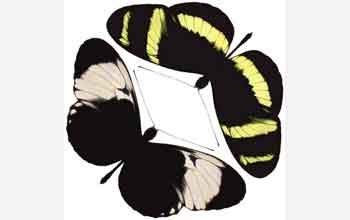Multimedia Gallery
Evolution of white Heliconius cydno and yellow Heliconius pachinus butterflies
Color pattern-based mate preference has led to the evolution of white (Heliconius cydno) and yellow (Heliconius pachinus) butterflies, considered two different species, from opposite coasts in Costa Rica. The butterflies were the focus of a study on the relationship between diverging color patterns in Heliconius and the long-term divergence of populations into new and distinct species.
More about this Image
Heliconius butterflies display incredible color pattern variation across Central and South America, with closely related species usually sporting different colors. In Costa Rica, for example, the two most closely related species differ in color: One species is white and the other yellow. In addition, both species display a marked preference to mate with butterflies of the same color.
In a study supported by the National Science Foundation and the National Institutes of Health, researchers discovered a population of tropical butterflies that may be on its way to splitting into two distinct species based on wing color and mate preference. In evolution, this process is called speciation--when one species branches into two that no longer interbreed.
The goal of the study, which was led by Mark Kronforst, a biologist at Harvard University, was to find out if the Ecuadoran Heliconius butterflies--which come in two colors, white and yellow--are undergoing the evolutionary process of speciation. In Ecuador, butterflies of both colors still live and mate with each other. Kronforst compared the Ecuadorian Heliconius butterflies with a community of the same species living in Costa Rica, that has already gone through speciation and the two colors are actually two different species.
In one study with the Ecuadoran butterflies, males were put in a cage with two virgin females, one of each color (white and yellow). After spending hours and hours watching the males court the females, the researchers found that the yellow males chose yellow females but the white males were ambivalent. Kronforst and colleagues believe that this subtle difference could mean that the one species is evolving into two distinct ones.
To try and verify this, the team used genetics to determine if the two colors were in fact still one distinct species. Scientists conducted a genome-wide scan and found that genetically, the two colors were a mixed population. Researchers believe these butterflies are possibly at a stage in speciation where the two colors are just starting to diverge. To learn more, see the NSF press release "Butterflies in the Same Milieu, Mate With Others of Like Hue." A paper by Kronforst and Ryan I. Hill (also from Harvard) titled "Polymorphic Butterfly Reveals the Missing Link in Ecological Speciation" was published in the Nov. 6, 2009, issue of Science magazine. (Date of Image: 2008-2009)
Credit: Marcus Kronforst, Harvard University
Images and other media in the National Science Foundation Multimedia Gallery are available for use in print and electronic material by NSF employees, members of the media, university staff, teachers and the general public. All media in the gallery are intended for personal, educational and nonprofit/non-commercial use only.
Images credited to the National Science Foundation, a federal agency, are in the public domain. The images were created by employees of the United States Government as part of their official duties or prepared by contractors as "works for hire" for NSF. You may freely use NSF-credited images and, at your discretion, credit NSF with a "Courtesy: National Science Foundation" notation.
Additional information about general usage can be found in Conditions.
Also Available:
Download the high-resolution JPG version of the image. (112 KB)
Use your mouse to right-click (Mac users may need to Ctrl-click) the link above and choose the option that will save the file or target to your computer.



 All images in this series
All images in this series